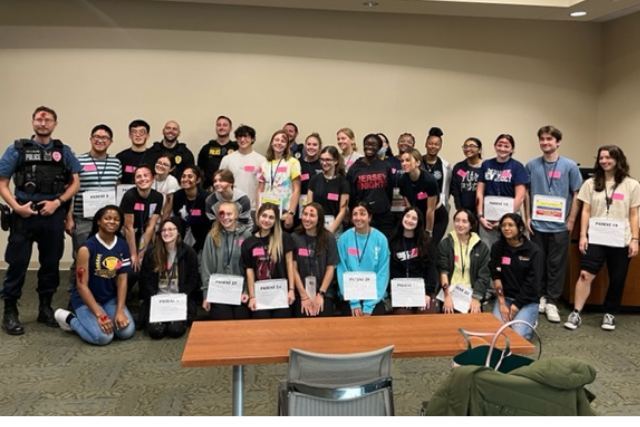TCNJ nursing students participated in a mass casualty drill in partnership with Capital Health earlier this month.
The drill provided an opportunity for 30 students to see how two different types of hospitals — the community-oriented Capital Health Medical Center in Hopewell and the more urban Capital Health Regional Trauma Center — handled an immediate influx of patients from a large-scale trauma event.
Each TCNJ student was assigned a wound or injury and was asked to act out the malady with as much authenticity as possible upon arrival to the hospital. Students were encouraged to scream, moan, yell, limp, cry — whatever it took to convey their assigned issue to the medical staff.
“Our students really showed their acting chops when it came to portraying the various injuries they were assigned,” said Tracy Perron, chair of the TCNJ Department of Nursing, who participated in the event. “They were yelling and screaming and dragging their friends into the hospital. They really did a great job being authentic.”
Some students arrived via the ambulance bay and others walked into various entrances at the hospital to mimic a real-life situation where the injured would not all arrive the same way to the same area of the hospital.
“Participating in this drill helped me better understand the interruption a mass casualty incident can have on the flow of a hospital,” said Sarah Curtis, a participating junior nursing major. “The empathy displayed by the nurses and other healthcare professionals made the entire process feel less like a drill and more like a real situation. Despite being a mock patient, the hospital staff never made me feel as if my ‘injuries’ were insignificant in comparison to a real patient at the hospital.”
In addition to seeing how an ER staff responds to a mass casualty situation, the experience allows the students to think about their own career paths in terms of what type of professional environment might best suit them.
“I think one of the biggest benefits of an exercise like this is the students can kind of see what trauma nursing is like in a real-world situation,” Perron said. “The students can see how the hospital staff work as a team and how they interact with their patients in a chaotic situation. Some feel right at home in a fast-paced, high-pressure situation like the Regional Trauma Center in Trenton. This type of simulation can help students determine which one may be better suited to their individual career path.”
Curtis, who was assigned neck and abdomen lacerations for the drill, felt the experience definitely provided some clarity for her in terms of what kinds of jobs she may pursue.
“The frantic nature of the emergency department environment felt exhilarating to me,” she said. “When I initially volunteered to participate in this exercise, my ultimate intention was to gain experience being in a clinical setting with professional healthcare personnel during a mass casualty incident. This experience led me to discover my desire to work in a fast-paced environment, whether it be in emergency or another department.”
The drill also provides many benefits to the hospitals in terms of training and preparing staff members but also growing connections within the community.
“Conducting exercises like these provides Capital Health an opportunity to test our emergency response capabilities and improve our response to real world disasters,” said Brian Therien, emergency management coordinator at Capital Health. “Through engaging with our external partners like TCNJ, Capital Health is able to further build upon its deep community roots. The participation and feedback of TCNJ students and faculty were invaluable to the successful execution of these exercises.”
— Luke Sacks

